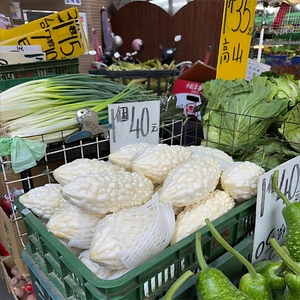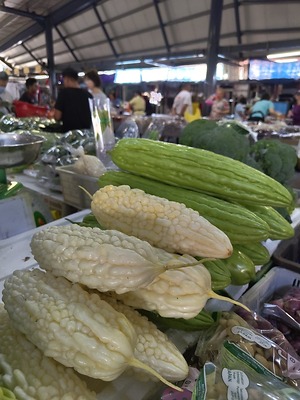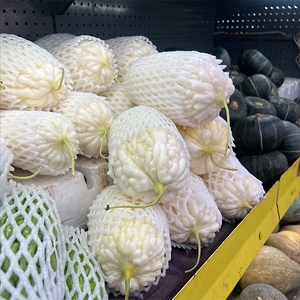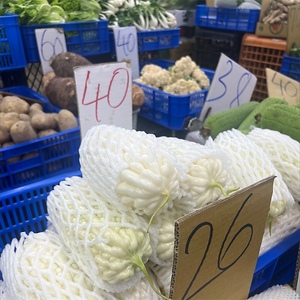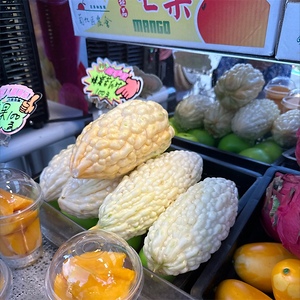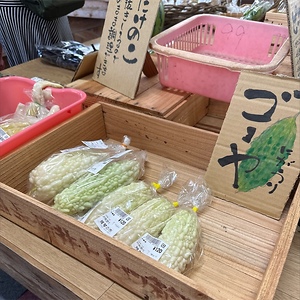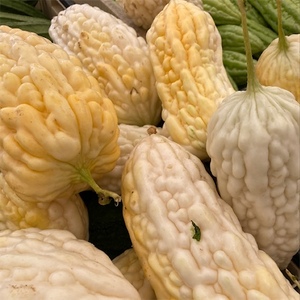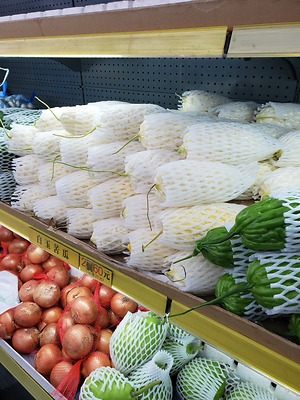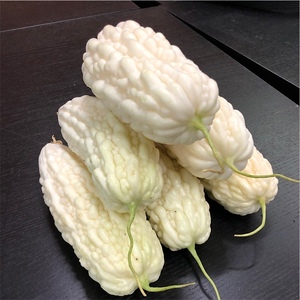

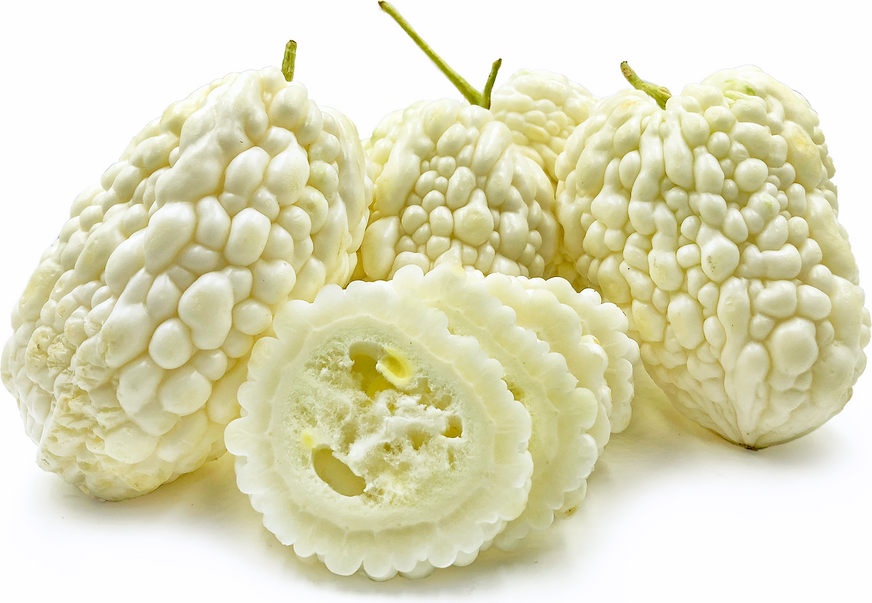
White Bitter Melons
Estimated Inventory, lb : 0
Description/Taste
White Bitter melons vary in size and shape, depending on the specific variety and growing region. Larger cultivars average 20 to 25 centimeters in length, while smaller types can be 5 to 10 centimeters. The fruits typically have a straight to slightly curved, oblong-tapered shape, and the skin is covered in defined ridges, bumps, and grooves. White Bitter melons have a smoother appearance than Indian bitter melon types, and the skin is edible, not needing to be peeled. Underneath the ivory to white, glossy exterior, White Bitter melons bear a layer of flesh encasing a central seed cavity. The seed cavity is filled with spongy pulp and large white to brown seeds. As the fruit matures, the seeds will develop a red fleshy coating. White Bitter melon flesh is crisp, aqueous, and crunchy with a refreshing and tender consistency. The flesh is edible raw or cooked and has a mild bitterness mixed with a subtle sweetness.
Seasons/Availability
White Bitter melons are available year-round, with a peak season in the summer and fall.
Current Facts
White Bitter melons, botanically classified as Momordica charantia, are a category of pale-skinned fruits belonging to the Cucurbitaceae family. Bitter melons grow on annual climbing vines extending 1.8 to 2.4 meters in length and are vigorous and fast-growing in nature. It is important to note that bitter melons are also called bitter gourds, and though botanically they are a fruit, they are primarily utilized as a vegetable in culinary preparations. Several varieties of White Bitter melons are found worldwide, and these varieties generally appear in two sizes, small and large. Smaller varieties are often referred to as apple bitter melons or gourds. Each growing region typically produces its own local varieties, and major seed companies also breed improved varieties. These regional and commercial varieties are collectively sold under the White Bitter melon name. White Bitter melons are valued for their distinct taste and nutritional properties, especially in Asia, and have expanded worldwide as a culinary ingredient in savory dishes.
Nutritional Value
White Bitter melons are not often distinguished from green types in nutritional studies. Bitter melons, in general, are a source of vitamins A, B, and C to strengthen the immune system, maintain healthy organs, and contribute to energy production in the body. Bitter melons also provide fiber to aid digestion and minerals like iron, potassium, calcium, phosphorus, and magnesium. Iron develops the protein hemoglobin for oxygen transport through the bloodstream, while potassium balances fluid levels within the body. Calcium and phosphorus support bone and teeth development, and magnesium helps control daily nerve functions. In Traditional Chinese Medicine, Bitter melons have antioxidant and anti-inflammatory properties and are believed to help detox the body and control blood sugar levels. The bitter taste within the species is derived from the presence of cucurbitacin, which is a natural compound used as a defense method against pests. These compounds taste bitter and appear in varying levels, depending on the specific variety.
Applications
White Bitter melons have a refreshing, mildly bitter, and subtly sweet taste suited for fresh and cooked preparations. They are primarily utilized in culinary preparations throughout Asia and can be used interchangeably with green bitter melons in recipes. White Bitter melons do not need to be soaked or salted before use and are thinly shaved and sliced in preparations to mitigate bitterness. It is recommended to remove the seeds and pulp before cutting, and once prepped, the flesh can be served hot or cold. In China and Taiwan, White Bitter melons are considered a cooling vegetable, popularly eaten during summer to dispel heat. The flesh is commonly sliced and stir-fried, cooked with aromatics, and tossed in flavorings like soy sauces, sesame oil, or oyster sauce for enhanced taste. White Bitter melon is also simmered in pork rib soup, a well-known dish in China, or added to curries, especially with coconut in Thailand. Across Asia, White Bitter melons are cooked and added to rice to create a balanced meal. Larger bitter melons can be hollowed and stuffed with pork, beef, or glass noodles and steamed. White Bitter melons are also stir-fried with eggs and tofu or paired with salted eggs. While less common, they are fried in China. In Japan, White Bitter melons are sometimes used in Oden cuisine, combined with radish, black bean curd, fried small fish, and bonito as a savory, bitter, and rich dish. They are also boiled, baked, grilled, and braised, or pickled for extended use. In Taiwan, bitter melons are juiced and mixed with honey in night markets as a beverage. They are also made into health teas. White Bitter melons pair well with aromatics like onions, ginger, garlic, and chile peppers, herbs such as cilantro and basil, and spices including turmeric, coriander, and black pepper. Whole, unopened bitter melons will keep for 3 to 5 days when stored in a plastic bag in the crisper drawer of the refrigerator. Bitter melons can also be sliced, blanched, and frozen for up to three months.
Ethnic/Cultural Info
White Bitter melons are notably a part of the artifact collection displayed at the Palace Museum in Taipei, Taiwan. The National Palace Museum was established in Beijing in 1925 and moved to Taipei in 1965. In the collection, three intertwined White Bitter melons crafted from jade are a well-known attraction, and the jade piece is believed to date back to the Qianlong period of the Qing Dynasty. Before the artifact arrived in Taiwan, it was held in the East Warm Pavilion of the Palace of Heavenly Purity in the Forbidden City. The jade bitter melon was also said to have inspired Taiwanese poet Yu Guangzhong in 1970. The poet saw the jade artifact at the museum and was moved to write the poem called “White Jade Bitter Gourd,” a piece in homage to the history and symbolism of bitter melon in culture.
Geography/History
Bitter melons, as a collective category under the species Momordica charantia, are thought to have origins in South and Southeast Asia. The exact center of origin of the wild species is still somewhat debated, and over time, cultivated types appeared from selective breeding. Scientists generally classify the cultivated types into two different strains labeled from South Asia and Southeast Asia. Southeast Asia strains are said to have increased diversity through extensive cultivation, and White Bitter melons are hypothesized to have arisen from this strain. Much of the history of White Bitter melons is unknown, but the type has been cultivated throughout Asia and is commercially produced in China and Taiwan. White Bitter melon is also found through smaller growers and family farms throughout Southeast Asia, Japan, and India. Outside of Asia, bitter melons were spread worldwide beginning in the 16th century. Today, White Bitter melons thrive in tropical to subtropical climates and have centralized production in Asia. When in season, White Bitter melons are sold through fresh markets, select retailers, and wholesalers.
Recipe Ideas
Recipes that include White Bitter Melons. One
| Chubby Panda |
|
Chinese Bitter Melon Stir-Fry |
| Pranee's Thai Kitchen |
|
Stir Fried Bitter Melon with Eggs |
| Modern Thai Food |
|
Stuffed Bitter Melon Soup |
| Teczcape |
|
White Bitter Melon Salad |



